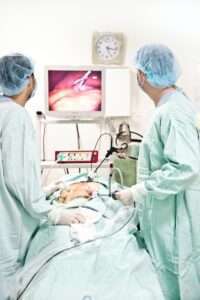The CDC states that there were 142,462 new colorectal cancers were reported In the United States in 20191. In addition, 51,896 people died from colorectal cancer that year. This post “This post “4 Reasons to Get a Colonoscopy in 2023” seeks to provide current and relevant information from a trusted source.
Colonoscopy2 is a procedure in which a doctor uses a colonoscope or scope, to look inside your rectum and colon. Colonoscopy can show irritated and swollen tissue, ulcers, polyps, and cancer NIH external link. This post “TB is 8 times higher for Black than White Americans” seeks to provide current and relevant information from a trusted source.
How is virtual colonoscopy different from colonoscopy3?
Virtual colonoscopy and colonoscopy are different in several ways:
- Virtual colonoscopy is an x-ray test, takes less time, and you don’t need anesthesia NIH external link.
- With virtual colonoscopy, your doctor doesn’t view the entire length of your colon.
- Virtual colonoscopy may not find certain polyps as easily as a colonoscopy can.
- Doctors can’t remove polyps or treat certain other problems during a virtual colonoscopy.
- Your health insurance coverage may be different for the two procedures.
Why do doctors use colonoscopy?
A colonoscopy can help a doctor find the cause of symptoms, such as
- bleeding from your anus
- changes in your bowel activity, such as diarrhea
- pain in your abdomen
- unexplained weight loss
Doctors also use colonoscopy as a screening tool for colon polyps and cancer NIH external link. Screening is testing for diseases when you have no symptoms. Screening may find diseases at an early stage, when a doctor has a better chance of curing the disease.

Screening for Colon and Rectal Cancer
Your doctor will recommend screening for colon and rectal cancer NIH external link —also called colorectal cancer—starting at age 45 if you don’t have health problems or risk factors that make you more likely to develop colon cancer.1
You have risk factors for colorectal cancer if you2
- are male
- are African American
- or someone in your family has had polyps or colorectal cancer
- have a personal history of inflammatory bowel disease, such as ulcerative colitis and Crohn’s disease
- have Lynch syndrome NIH external link, or another genetic disorder that increases the risk of colorectal cancer
- have other factors, such as that you weigh too much or smoke cigarettes NIH external link
If you are more likely to develop colorectal cancer, your doctor may recommend screening at a younger age, and more often.
If you are older than age 75, talk with your doctor about whether you should be screened. For more information, read the current colorectal cancer screening guidelines External link from the U.S. Preventive Services Task Force (USPSTF).
Government health insurance plans, such as Medicare, and private insurance plans sometimes change whether and how often they pay for cancer screening tests. Check with your insurance plan to find out how often your plan will cover a screening colonoscopy.

How do I prepare for a colonoscopy?
To prepare for a colonoscopy, you will need to talk with your doctor, change your diet for a few days, clean out your bowel, and arrange for a ride home after the procedure.
Talk with your doctor
You should talk with your doctor about any health problems you have and all prescribed and over-the-counter medicines, vitamins, and supplements you take, including
- arthritis medicines NIH external link
- aspirin NIH external link or medicines that contain aspirin
- blood thinners NIH external link
- diabetes medicines
- nonsteroidal anti-inflammatory drugs such as ibuprofen NIH external link or naproxen NIH external link
- vitamins that contain iron or iron supplements
Change your diet and clean out your bowel
A health care professional will give you written bowel prep instructions to follow at home before the procedure so that little or no stool remains in your intestine. A complete bowel prep lets you pass stool that is clear and liquid. Stool inside your intestine can prevent your doctor from clearly seeing the lining.
You may need to follow a clear liquid diet for 1 to 3 days before the procedure. You should avoid red and purple-colored drinks or gelatin. The instructions will include details about when to start and stop the clear liquid diet. In most cases, you may drink or eat the following:
- fat-free bouillon or broth
- gelatin in flavors such as lemon, lime, or orange
- plain coffee or tea, without cream or milk
- sports drinks in flavors such as lemon, lime, or orange
- strained fruit juice, such as apple or white grape—avoid orange juice
- water

Different bowel preps may contain different combinations of laxatives—pills that you swallow or powders that you dissolve in water or clear liquids. Some people will need to drink a large amount, often a gallon, of liquid laxative over a scheduled amount of time—most often the night before and the morning of the procedure. Your doctor may also prescribe an enema.
The bowel prep will cause diarrhea, so you should stay close to a bathroom. You may find this part of the bowel prep hard; however, finishing the prep is very important. Call a health care professional if you have side effects that keep you from finishing the prep.
Your doctor will tell you how long before the procedure you should have nothing by mouth.
Arrange for a ride home
For safety reasons, you can’t drive for 24 hours after the procedure, as the sedatives or anesthesia need time to wear off. You will need to make plans for getting a ride home after the procedure.
How do doctors perform a colonoscopy?
A doctor performs a colonoscopy in a hospital or an outpatient center. A colonoscopy usually takes 30 to 60 minutes.
A health care professional will place an intravenous (IV) needle in a vein in your arm or hand to give you sedatives, anesthesia, or pain medicine, so you won’t be aware or feel pain during the procedure. The health care staff will check your vital signs and keep you as comfortable as possible.
For the procedure, you’ll lie on a table while the doctor inserts a colonoscope through your anus and into your rectum and colon. The scope inflates your large intestine with air for a better view. The camera sends a video image to a monitor, allowing the doctor to examine your large intestine.
The doctor may move you several times on the table to adjust the scope for better viewing. Once the scope reaches the opening to your small intestine, the doctor slowly
 removes the scope and examines the lining of your large intestine again.
removes the scope and examines the lining of your large intestine again.
During the procedure, the doctor may remove polyps and will send them to a lab for testing. You will not feel the polyp removal. Colon polyps are common in adults and are harmless in most cases. However, most colon cancer begins as a polyp, so removing polyps early helps to prevent cancer.
If your doctor finds abnormal tissue, he or she may perform a biopsy. You won’t feel the biopsy.
What should I expect after a colonoscopy?
After a colonoscopy, you can expect the following:
- The anesthesia takes time to wear off completely. You’ll stay at the hospital or outpatient center for 1 to 2 hours after the procedure.
You may feel cramping in your abdomen or bloating during the first hour after the procedure.- After the procedure, you—or a friend or family member—will receive instructions on how to care for yourself after the procedure. You should follow all instructions.
- You’ll need your pre-arranged ride home, since you won’t be able to drive after the procedure.
- You should expect a full recovery and return to your normal diet by the next day.
After the sedatives or anesthesia wear off, your doctor may share what was found during the procedure with you or, if you choose, with a friend or family member.
If the doctor removed polyps or performed a biopsy, you may have light bleeding from your anus. This bleeding is normal. A pathologist will examine the biopsy tissue, and results take a few days or longer to come back. A health care professional will call you or schedule an appointment to go over the results.
What are the risks of colonoscopy?
The risks of colonoscopy include
- bleeding
- perforation of the colon
- a reaction to the sedative, including breathing or heart problems
- severe pain in your abdomen
- death, although this risk is rare
A study of screening colonoscopies found roughly 4 to 8 serious complications for every 10,000 procedures.3
Bleeding and perforation are the most common complications from colonoscopy. Most cases of bleeding occur in patients who have polyps removed. The doctor can treat bleeding that happens during the colonoscopy right away.
You may have delayed bleeding up to 2 weeks after the procedure. The doctor can diagnose and treat delayed bleeding with a repeat colonoscopy. The doctor may need to treat perforation with surgery.

Seek Care Right Away
If you have any of the following symptoms after a colonoscopy, seek medical care right away:
- severe pain in your abdomen
- fever
- bloody bowel movements that do not get better
- bleeding from the anus that does not stop
- dizziness
- weakness
Jay Harold hopes you enjoyed this post, “4 Reasons to Get a Colonoscopy in 2023.” Please share it and read more about Jay Harold here. Please take this advice from Muhammad Ali and give it back to others. “Service to others is the rent you pay for your room here on earth.”
Click this link to get free Health and Wealth information to improve your life. Play the free “Slow Roll Through Civil Rights” Game found on the Jay Harold website. Enjoyed this post? Share it and read more here.




